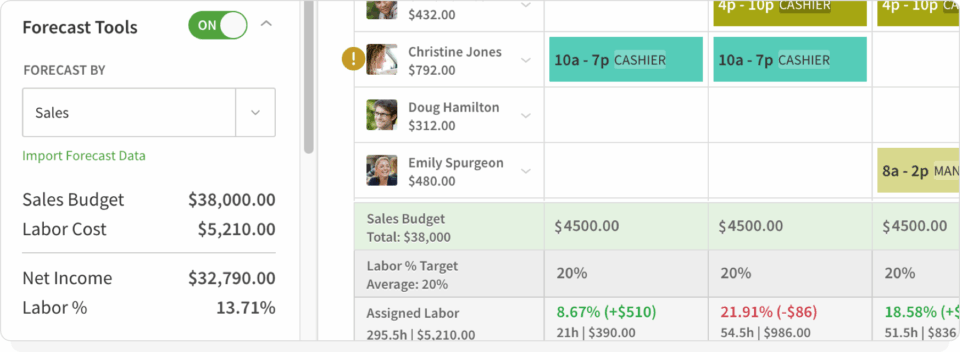Dealing With Employee Burnout: Causes, Signs, And 7 Strategies
Try When I Work for free
Employee burnout is a real problem. Maybe you think it only happens in spectacularly bad workplaces, but you’d be wrong.
It’s not just the culture of the workplace or the amount of work an employee faces, but the experience and emotions surrounding that work that matter. Emotional and mental exhaustion are a crucial part of the employee burnout equation, and they can be activated by more than just a toxic environment or a measurable workload.
At When I Work, we focus on employee scheduling, time tracking, and team messaging. Scheduling is at the forefront of burnout—where it starts and where it can end. So here are some effective strategies to help you see what causes burnout, how to stop it, and how to avoid it in the future.
Key takeaways:
- Emotional and mental exhaustion play a significant role in employee burnout
- Common signs of burnout include decreased performance, increased absenteeism, emotional outbursts, and negative customer interactions.
- Employees who feel undervalued, overworked, or lack support are at high risk of burnout
- You can reduce burnout by offering rewards and be a support to your employees
- A healthy workplace environment and ensuring fair treatment can also help reduce burnout
What is employee burnout?
The World Health Organization says that employee burnout consists of three things:
- Feelings of energy depletion or exhaustion.
- Growing mental distance from an employee’s job, or negative or cynical feelings towards the job.
- Reduced professional efficiency or productivity.
How common is employee burnout?
Burnout is at an all-time high, with 66% of employees feeling burned out in some way. Younger generations are faring way worse, with 81% of workers aged 18-24 reporting burnout and 83% of workers aged 25-34 reporting the same.
How to know if employee burnout is happening in your workplace
There are some common signs of worker burnout, like poor work performance, increased absenteeism, more emotions coming out, and negative customer feedback.
If your employees are starting to feel out of control or that they’re taken for granted and not rewarded, it’s time to pay attention. Don’t forget that if there’s no sense of team or unified goal—maybe some employees are working harder than others on the team, or some employees are treated unfairly—burnout is imminent.
Related article: 5 Signs Your Employees Are Overworked – And What To Do About It
What can you do to help employees and prevent burnout? 7 strategies to try
Here are seven ways you can help prevent employee burnout at your workplace.
1. Get serious about mental health
More and more we see mental health issues arising in the news and the sometimes shocking results from people whose mental health has been ignored and degraded.
You have to take the mental health of your employees seriously.
Even though it is illegal for employers to penalize employees based on their mental health or to act outside of specific boundaries, that doesn’t stop a person from being wary about being honest about their mental state. How many employees are likely to answer tough mental health questions from their employer honestly when directly confronted? This is especially so if you’re asking the questions in the context of a performance review.
There are several ways to keep employee mental health a priority without being invasive:
- Use an emotional rating system. A rating system (e.g. a scale of one to ten) might be easier for some employees than talking specifics. You could use a rating system, whether anonymous or not, to determine the mental health and emotional state of your workforce. The results of such a system will help you know where improvement or help is needed.
- Talk about mental health to the general group, and not to specific people. You can avoid legal issues, or uncomfortable situations, if you talk about mental health as a group instead of targeting one person.
- Be confidential and private. Some employees may feel open and comfortable talking to you about their mental health. As long as you don’t break any laws, that is fine. But always always always keep what you talk about confidential! If you tell someone else, word will get around that your office isn’t a place where confidentiality is guaranteed.
- Teach your employees how to be mentally healthy. You probably have other on-the-job training or meetings. Make mental health just as important. Teach your employees how to deal with personal and work issues, how to cope with stress, and other mental health topics. Bring in mental health professionals to teach your team these things, and offer confidential consultations with them.
- Learn to spot mental health issues. While you can’t be expected to read minds or act as a mental health professional, you can learn to spot some issues. Managers should be trained on what to look for in employees who might need some help or encouragement.
Depression, anxiety, fear, anger—all of these are devastating to the individual employee and to the workplace. Employee burnout is directly connected with mental health.

2. Offer rewards that work against employee burnout
Rewards come about for different reasons.
We mostly think of them as a kind of carrot on a stick, dangling something of value in front of our employees to get them to work harder and do more.
Sounds logical, but remember two things about that approach:
- You can only cajole so far before the reward isn’t a motivator.
- The continued pressure to work harder to achieve a reward can lead to…employee burnout.
Rewards of that nature have their place, but if all perks and rewards are performance-based, you set employees on a path of burnout.
This is a world that makes your employees question their worth. They have to be on and earning and climbing the ladder or they don’t matter. That’s a rat on a wheel. Use genuine and heartfelt rewards to let them learn a different existence.
Whether it’s a gift card, extra break time, some bonus paid vacation hours, you picking up their work or the end of a shift so they can leave early, or amazing snacks in the break room, letting a person know they have value whether or not they created monetary value for you goes a seriously long way.
Related read: 25 Employee Incentive Ideas To Motivate Your Team
3. Avoid punitive knee-jerk responses
Let’s say you have an employee struggling with burnout. They aren’t comfortable coming right out and telling you, either because of the workplace culture, your managerial style, the response other employees have received, or maybe because they aren’t fully aware of what’s going on in themselves.
So they are passively or subtly trying to let you know something’s not right. Maybe it’s side comments that you think are evidence of insubordination or a lack of respect. Maybe they’re starting to get their work done late or they just seem down or cold toward you.
Before you get out the public stocks, ask yourself:
- Is this how my employee has typically behaved?
- Are they usually a reliable or high-performing employee?
- Does this seem out of character?
If the employee has been a complaining slouch their entire time working for you, that’s one thing. But if they’ve been a great employee and cracks are starting to show, that needs to be part of the context of understanding what’s going on.
Talk to the employee privately. If you have a personality that responds quickly, choose to listen instead. Control your facial and verbal expressions and let the employee speak. Don’t listen just to formulate a response to the contrary, but listen to hear and seriously consider what they say. Don’t take it personally. Rethink what you’ve expected of this employee and be willing to make some changes to avoid this happening again.
4. Temper your bottom-line enthusiasm when scheduling
You have a business to run and customers to satisfy—that’s understood. It’s easy to put that as the most important consideration and create conditions that burn through employees.
Maybe reconsider that approach. Take it easy on how you schedule shifts.
Communicate as early as you can so employees aren’t saddled with a huge pile of last-minute stress every week. That stress adds up. They might be able to handle the work, but the last-minute changes and requests are causing the burnout.
Use a tool like When I Work, which can help you build the schedule faster, so you can share it sooner with your team. Also, you can use labor forecasting to make sure you get the right amount of employees on the right shifts, so you’re not constantly understaffed, which can be a key contributor to burnout.
5. Consider employee off-hour obligations
You probably are aware of how to value and respect your employees personal lives and time. That’s been drummed into you over the years.
So consider this: do you value the other jobs the employee has to do that aren’t for you?
You may have employees who are working another job. Or maybe they do some freelance work on the side to make ends meet. Maybe you aren’t able to pay a wage they can live off of, or they only work part-time. Whatever the reason, you probably have employees who are almost always on the clock for someone, even if it isn’t you.
Be considerate. While the other work should never conflict or interfere with what you pay an employee to do, keep in mind that juggling multiple jobs to make ends meet creates a sense of depression, hopelessness, and weariness.
Talk to your employee. Find out how you can work with them in the situation. Clarify what you expect, but also let them know what you aren’t demanding of them.
When I Work can help by making it easy to track employee availability. Let them put in when they can work, and the system keeps track of that, so you won’t schedule them when they need free time for themselves.

6. Make goals available for all
Some jobs give employees the chance to advance to a higher position. But some jobs are “dead-end jobs.” They don’t have any chance for advancement. That job is the end of the line, unless you go work somewhere else.
It simply isn’t possible for every job to have a chance to be promoted in the classical sense, but it is possible to create goals to fulfill that need to have a reason for working.
You need to create goals for your employees, which may include some of the following:
- Monetary goals. Everyone can use extra money. So, at the very least, make employee raises regular and realistic. At least it provides a chance for a wage increase.
- Experiential training goals. Make conferences or valuable experiential training opportunities available as a long-term goal. This isn’t just bringing in HR over the lunch hour with worksheets, but sending an employee to a conference elsewhere to be energized and get excited about work again.
- Micro-position goals. While you might not be able to create bona fide managerial positions (vertical) to promote people in, you can create micro-positions (horizontal) for employees. This means you might create a shift safety officer, for example, which comes with a slight raise and a few new duties and perks. This is particularly useful if you have employees who are struggling to grasp all of their job, since you can use micro-positions to get each employee to focus on specific things in addition to the regular job. It’s a team with specialization built in.
When I Work makes this easy with Tags and pay differentials. You can create Tags for micro-positions, which factors into shift eligibility. Plus, you’ll know when they’re working those shifts, so the software knows when to apply the pay differential.
7. Keep tabs on workplace culture
Some of the emotional and mental health issues that are involved in employee burnout have to do with a poor workplace culture fit.
While some cultural aspects may be set, consider the areas you can easily change.
- Reduce the time pressure and pace wherever possible. That reduces stress. Shift emphasis from output to the human factor.
- Make sure management is top-notch in communicating with employees.
- Check the workload expected of each employee. Maybe you need to hire more staff instead of bragging about the long hours your employees put in.
- Define expectations and roles. You might think a culture free of definition and delineation is great, but many employees prefer to have guidelines to work in. Guidelines remove the fear and worry about not being sure about what is expected. They provide stability and reduce conflict with other employees who encroach on their territory.
- Have buffer zones from customers. Managers or customer care specialists should be in place to protect your employees from unreasonable and aggressive customers.
Your culture is a failure if people are not sure what they should be doing, how much they should be doing, and if they can take a needed break without derailing everyone.
Remember, employee burnout comes from more than just too much work. It happens when employees are weary, worried, stressed, depressed, upset, feel trapped, fearful, or lack a sense of community where others are working just as hard alongside them.
In other words, employee burnout doesn’t have a cookie cutter fix. But you must fix it if you want to reduce employee turnover, absenteeism, or poor customer experience.
Understanding the effects of employee burnout on your business
Burnout affects everyone in your business. You have to deal with the fallout of unhappy employees and increased turnover. While your main concern should definitely be for the health and safety of your workers, just know that staff burnout has a direct effect on customers and their experience, too.
Employee burnout causes an estimated $300 billion a year in absenteeism, turnover, decreased productivity, and healthcare costs. Burnt out employees are more likely to call out sick, leave for another job, or give less-than-ideal service to customers.
So while you’re spending more money on replacing workers who leave and constantly updating the work schedule to handle increased absenteeism, your customers are getting worse service and may not come back.
Related article: Why Employee Burnout Is Harmful To Your Business
Overcoming employee burnout with When I Work
Knowing the causes, signs, and strategies to help overcome employee burnout are key to keeping a happy, productive workplace. Another great way to stay in front of staff burnout is to use flexible scheduling to help your employees manage their schedules in a way that’s best for both of you. Use When I Work to build the schedule in minutes, with flexible scheduling built right in.
Sign up today for your 14-day FREE trial and get started now!






